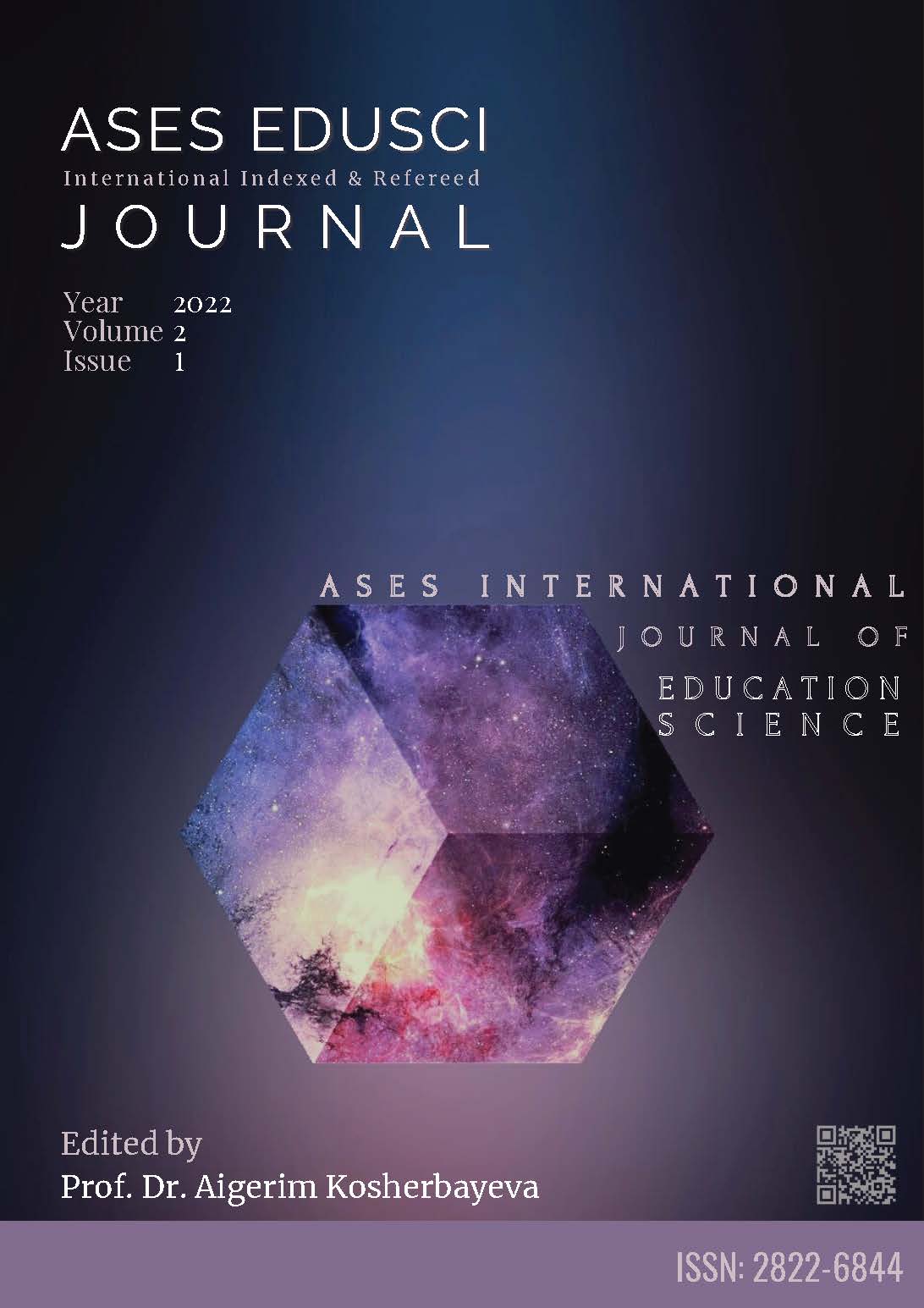THE EFFECT OF SUPERHERO CARTOONS ON SELF-CONFIDENCE OF PRIMARY SCHOOL STUDENTS
DOI:
https://doi.org/10.5281/zenodo.7732849Anahtar Kelimeler:
Values,, Primary school students, superhero, cartoon, self-confidenceÖzet
The aim of this study is to determine the effect of superhero cartoons on self-confidence in primary school students. The sample of the research consists of 8 students who attend primary school in the 2020-2021 academic year, determined by purposeful sampling. Participants are between the ages of 8-10. Interview technique, one of the qualitative research methods, was used in the research. The opinions of the participants were taken with a semi-structured interview form by taking expert opinions. After the expert's opinion, 8 open-ended interview questions and demographic features were included in the form. Researchers independently coded the interview records and then common codes were determined. The codes were reanalyzed and categories were created. For the validity and reliability of the research, besides the volunteering of the participants, direct quotations were made under the table and shared with other researchers. The reliability of the study was calculated as 85%. The codes created by the participants with their definitions of self-confidence, “Confidence in oneself, not afraid of anything and not being ashamed”, the codes they created about watching cartoons and their reasons for choosing “Adventure and Action”, the codes they created about wanting to be like a superhero in a cartoon “yes”. The codes they created for being self-confident like those superheroes in real life were determined as “flying, solving problems and helping people”. 4 categories in the first, third and fourth sub-problems; 5 categories in the fifth, seventh and eighth sub-problems; and 6 categories were determined in the second and sixth sub-problems. The fact that children's virtual and TV watching is under family control is of great importance in terms of their personal development. Individuals' monitoring should be in line with family, community and value judgments. In addition, the content of individuals' monitoring should be supported by moral value judgments.
Referanslar
Akçalı, O. G. (2007). Müzik öğretmenlerinin eğitim müziğinde çoksesli eşliklemeye yaklaşımları ve eşlikte harf şifre yöntemini kullanma durumları (Master's thesis, Afyon Kocatepe Üniversitesi, Sosyal Bilimler Enstitüsü). Alabay, E. (2020). “Kahramanın Kim?”: Okul öncesi dönem çocuklarının kahramanlarının incelenmesi. Erken Çocukluk Çalışmaları Dergisi, 4(1), 152-171. Altmış, Z. G., & Altun, M. (2021). “Pırıl” Çizgi Filminin Değerler Eğitimi Açısından Değerlendirilmesi. OPUS Uluslararası Toplum Araştırmaları Dergisi, 17(38), 5382-5411.
Atalay, A., Nural, E., & Ada, Ş.(2021). Okul Öncesi Çocuklarda Görülen İstenmeyen Davranışların Önlenmesinde Tiyatronun Etkisine İlişkin Öğretmen Görüşleri. Ulusal Eğitim Akademisi Dergisi, 5(2), 223-238. Berk, L. E. (2013). Bebekler ve çocuklar. N. Işıkoğlu, Çev.) Ankara: Nobel. Coşkunçay, F. H. (2019). İlkokul 3. Ve 4. sınıf öğrencilerinin Ders çalışma alışkanlıklarına çizgi Filmlerin Etkisinin Incelenmesi (Doctoral dissertation, Marmara Universitesi (Turkey)). Çilenti, K. (1984). Eğitim Teknolojisi Ve Öğretim, Ankara: Özel Yayın. Darga, H., Öztürk, F. Z., & Öztürk, T. Çizgi Filmlerin Çocukların Dil ve Sosyal Gelişim Alanlarına Etkisine Yönelik Ebeveyn Görüşlerinin İncelenmesi. International Primary Education Research Journal, 5(1), 59-77. Doğan, A., & Göker, G. (2012). Tematik Televizyon Ve Çocuk: İlköğretim Öğrencilerinin Televizyon İzleme Alişkanliklari. Milli Eğitim Dergisi, 42(194), 5-30. Karaca, G. (2011). 5-8 Yaş aralığındaki çocuklarda stereotip (klişe resim) kullanımı. Mehmet Akif Ersoy Üniversitesi Sosyal Bilimler Enstitüsü Dergisi, 3(4), 86-93. Kernan, M. (2007). Play as context for early learning and development.. Dublin:NCCA
Merriam, S. B. (2013). Nitel araştırma: Desen ve uygulama için bir rehber (3. Baskıdan Çeviri, Çeviri Editörü: S. Turan). Ankara: Nobel Yayın Dağıtım. Öztürk, C., & Karayağız, G. (2007). Çocuk ve televizyon. Anadolu Hemşirelik ve Ravikiran, S. R., Baliga, B. S., Jain, A., & Kotian, M. S. (2014). Factors influencing the television viewing practices of Indian children.The Indian Journal of Pediatrics,81(2), 114-119.https://doi.org/10.1007/s12098-013-1164-y Rideout VJ, Vandewater EA, Wartella EA. Zero to Six: Electronic Media in the Lives of Infants, Toddlers andPreschoolers. A Kaiser Family Foundation Report, 2003. Samur, A. Ö., Demirhan, T. D., Soydan, S., & Önkol, L. (2014). Pepee çizgi filminin ebeveyn öğretmen ve çocuk gözüyle değerlendirilmesi/assesment of pepee cartoon from perspectives of parents teachers and children. Mustafa Kemal Üniversitesi Sosyal Bilimler Enstitüsü Dergisi, 11(26), 151-166. Sarıçam, H. Çizgi Film Programlarının Çocuklara Etkisi Konu-sunda Ailelerin Bilgi ve Farkındalık Düzeylerinin İncelenmesi 1...Sağlık Bilimleri Dergisi, 10(2), 81-85. Tokdemir, M., Deveci, S. E., Açık, Y., Yağmur, M., Gülbayrak, C. ve Türkoğlu, A.R.(2009) İlköğretim Öğrencilerinin Fiziksel Şiddete Başvurma ve Fiziksel Şiddete Yaklaşımlarında Televizyon Programlarının Etkisi. Türkiye Klinikleri Adli Tıp Dergisi, Cilt: 6 Sayı: 2 Yaşar Ekici, F. (2015). Çizgi filmlerin çocuklar üzerindeki etkilerine ilişkin çok boyutlu bir değerlendirme. Türk & İslam Dünyası Sosyal Araştırmalar Dergisi, 2(5), Aralık, 70-84. Yener, Y., Yılmaz, M., & Mert, Ş. E. N. (2021). Çizgi filmlerde değer eğitimi: TRT Çocuk örneği. International Journal of Social Sciences and Education Research, 7(2), 114-128. Yetim, G., & Sarıçam, H. (2016). Çizgi film programlarının çocuklara etkisi konusunda ailelerin bilgi ve farkındalık düzeylerinin incelenmesi. OPUS Uluslararası Toplum Araştırmaları Dergisi, 6(11), 341-364.
Yıldırım, A. ve Şimşek, H. (2011). Sosyal bilimlerde nitel araştırma yöntemleri (8.baskı). Ankara: Seçkin Yayıncılık.
İndir
Yayınlanmış
Nasıl Atıf Yapılır
Sayı
Bölüm
Lisans
Telif Hakkı (c) 2022 ASES EDUSCI (INTERNATIONAL JOURNAL OF EDUCATIONAL SCIENCES) ISSN: 2822-6844

Bu çalışma Creative Commons Attribution-NonCommercial 4.0 International License ile lisanslanmıştır.


